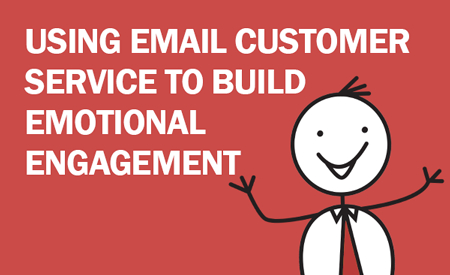Using email customer service to build emotional engagement

Email has been a mainstay of customer service since its inception, providing a digital alternative to the telephone for consumers. Despite the growth of other digital channels, such as social media and chat, it continues to thrive – 69% of people still want to contact companies through email, according to Forrester. In some sectors (such as retail), email makes up 30% of customer service interactions. This means that even midsize organizations are receiving hundreds, if not thousands of emails every day.
However, what has changed is why and when email is used – and consequently how companies need to structure their customer service around the channel. Email is no longer the only digital channel available and needs to be seen as part of a complete, joined-up customer service offering.
So why do people use email and how should companies respond?
1. When the request is complex
Today’s consumers want speed and simplicity when dealing with organizations. This means that no matter how fast a company responds on the email channel, the total interaction is likely to take longer than finding the answer to a routine question on a company’s website. Therefore, provided your organization has installed self-service on its site powered by a knowledge base of constantly updated information, the majority of queries received through email will concern more complex matters. For that reason, agents answering email need to be empowered through access to the right information and also to the business systems required to check customer-specific details in order to provide a personalized response. That way they can deliver fast, accurate answers that enhance the customer experience.
2. When the customer requires an audit trail
Particularly in regulated industries or if the customer is making a complaint, they want to have a written record of the interaction. This simply isn’t possible over the telephone and the shorter structure of social media messages also makes it difficult to provide a full audit of the interaction. Instead they turn to email, as it provides a stored, comprehensive and time stamped record that can be easily printed or shared. Customers need to bear this in mind and ensure that all email responses are consistent and meet company policies and regulatory guidelines.
3. When the customer wants to interact on an emotional level
Self-service systems provide information but they obviously don’t let consumers engage with a person. Whether it is to make a complaint, give praise or simply provide feedback, people want the human touch when emotion is involved. This provides challenges and opportunities to companies, and their contact center agents answering emails:
- It can be difficult to understand the tone and language customers use, hampering engagement. Eptica research found that 78% of consumers listed a lack of understanding of their query on digital channels such as email as one of their two biggest frustrations. Agents agreed, with 61% saying they found to understand what customers were asking online. Technologies such linguistics, which can be used to analyze incoming emails based on their content, help here – enabling companies to prioritize responses and allow agents to engage on an emotional level.
- Companies receive thousands of emails every day. However, to the consumer, this could be their only interaction with a brand that day or even week. Fail to deal with it properly and there will be significant damage to the customer relationship. Using a combination of templates and personalized responses can help ensure that every response is both tailored, yet consistent.
- Specific customer groups (such as Millennials and Baby Boomers) expect to be treated differently, particularly when it comes to the language and tone you use to respond. Recent research found that 65% of consumers prefer a casual tone in email responses – except if the agent is denying a request. In this case nearly 8 in 10 (78%) say casual language has a negative impact on the experience. Understand your customers and structure responses accordingly.
4. When the request doesn’t need an instant answer
In a time-critical situation, a customer is likely to pick up the phone or make contact through web chat (if available). So email is used for the slightly less urgent cases, where customers want to have confidence that their query has been understood, information gathered and that the response is thought through and tailored to their needs. This doesn’t mean they are happy to wait for a long time for an answer – according to Eptica research 58% of US consumers would like to receive an email reply within 2 hours. However, the same study found that the average response time of 500 US retailers was 7 hours and 51 minutes – nearly four times as long.
Failing to respond quickly on email has two major impacts on a company. Firstly, the customer is annoyed, damaging the relationship, while they may well send follow-up chaser emails or switch to other channels, to try and get an answer. This wastes their time, but also leads to inefficiency for the company concerned as interaction volumes increase, with more emails needing to be dealt with. One way around this is to acknowledge all emails and provide a realistic timeframe for response that fits with customer expectations.
Email is still a central channel for customer service, meaning that companies need to ensure that it receives the necessary focus, resources and technology spend, if they are to deliver the experience that consumers demand, now and in the future.







Comments